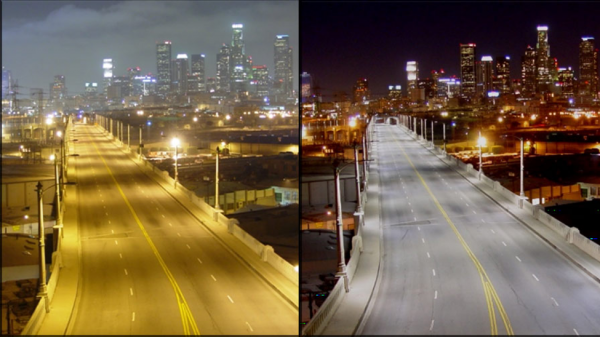A Dark Night Sky in Los Angeles
In 1994, an earthquake struck Los Angeles, California, causing a blackout that darkened the night sky. Reports came flooding in through 911 servers of “‘a giant silvery cloud’” filling the sky.[1] The “cloud” over Los Angeles that night was nothing other than the Milky Way, which was typically invisible due to the city’s light pollution. Light pollution is the brightening of the night sky caused by streetlights and other man-made sources, disrupting natural cycles.[2] People living in increasingly light polluted urban environments are losing their historical and emotional connection with the unlit night sky. David Henderson, author of Valuing the Stars: On the Economics of Light Pollution, writes: “The cultural, aesthetic and religious value of the night sky is rich, intense, and no mere sentimentalism… the value of stars to people across the ages is abundant and profound.”[3] This analysis gestures towards the deeper responsibility people have to protect the night sky for human society and for all living things.

The Science of Starry Skies
The scientific understanding of light pollution’s consequences has evolved over time, leading some communities to seek to limit light pollution locally, and others to regulate it on a national scale. Astronomers became aware of light pollution’s impact on observatories starting in the 1950s. In 1958, Flagstaff, Arizona decided to regulate street lighting to protect the Lowell Observatory’s ability to observe the night sky. Tucson, Arizona home of the Kitt Peak Observatory, followed suit in 1972.[4] Internationally, France and other European nations have recognized the impact of light pollution and restricted artificial light to particular times of day. Over time, light pollution regulation will curb unnecessary light, cut carbon emissions, and bring down energy costs.[5] In France, these measures are expected to save about 200 million Euros ($266 million USD) by cutting energy use.[6] While nationally the US has lagged behind Europe in regulating light pollution, federally-managed lands are helping to preserve Americans’ night skies.
The Benefit of a Dark Night Sky
Unlit skies are not only beautiful, they also protect the habitat and mating cycles of numerous animal species, such as sea turtles. From May to November in Florida, more than 5,000 turtles nest at NASA’s Kennedy Space Center’s Merritt Island Wildlife Refuge and on nearby Canaveral National Seashore. Turtles rely on the moon to guide them back to water, and unblocked artificial lighting interferes with the turtles’ navigation. Since 1995, the Space Center has included turtle-safe lighting in its buildings and infrastructure and is looking at ways to further limit lights inside its buildings from reaching the beach, safeguarding species sensitive to light pollution.[7]
Other types of public land also help preserve dark skies. In the US, twenty-six of the fifty-eight National Parks are designated as dark-sky parks, where the National Park Service restricts artificial light.[8] One of the darkest international dark sky sanctuaries in the world lies on public land in the Nevada desert: Massacre Rim. Located on Bureau of Land Management lands, the International Dark-Sky Association (IDSA) maintains the sanctuary. Founded in 1988, IDSA is a nonprofit organization dedicated to “[protecting] night skies for present and future generations.” [9] People visiting these public lands can experience the night sky’s beauty and advocate for measures to limit light pollution in their own communities.
We Can All Make a Difference
As cities and industrial operations light up the night, the public’s access to dark skies is fading. While sources vary, an estimated 80 percent of the planet’s land mass lies under skies where the Milky Way has become invisible due to light pollution.[10] By designating more public lands as dark sky sanctuaries, we can preserve access to dark night skies. One way to explore light pollution’s impact on your local environment is by using the NASA Blue Marble Navigator or the World Atlas of the Artificial Night Sky Brightness.
–By Belle Wilson, Rocky Mountain High School Student Contributor and Ariel Schnee, PLHC Program Manager
Published 04/02/2020
Sources
[1] Coetzee, Bernard. “Light Pollution: The Dark Side of Keeping the Lights on.” Phys.org. April 03, 2019. Accessed April 24, 2019. https://phys.org/news/2019-04-pollution-dark-side.html.
[2] Ibid.
[3] Henderson, David. “Valuing the Stars: On the Economics of Light Pollution.” Environmental Philosophy 7, no. 1 (2010): 22. http://www.jstor.org/stable/26168027.
[4] Challéat, Samuel, Floriane Chouraqui, Jean-Pascal Fontorbes Jacob T. Matthews, and Anne-Marie Granié. “The Night Sky and the Risks of Light Pollution.” Mondes Sociaux, February 1, 2018. https://sms.hypotheses.org/10810.
[5] Bogard, Paul. “Bringing Back the Night: A Fight Against Light Pollution.” Yale E360, Yale School of Forestry & Environmental Studies, 19 Aug. 2013, e360.yale.edu/features/bringing_back_the_night__a_fight_against_light_pollution.
[6] ibid
[7] Herridge, Linda. “Dark Skies Essential for Sea Turtle Nesting Season.” NASA, NASA, 18 Feb. 2015, www.nasa.gov/content/kennedy-space-center-keeps-dark-skies-for-sea-turtle-nesting.
[8] NPCA. “Celebrate Dark Skies at These 26 National Parks.” National Parks Conservation Association. NATIONAL PARKS CONSERVATION ASSOCIATION, July 25, 2019. https://www.npca.org/articles/1806-celebrate-dark-skies-at-these-26-national-parks.
[9] International Dark-Sky Association, “Public Lands at Massacre Rim Named International Dark Sky Sanctuary”. International Dark-Sky Association. April 01, 2019. Accessed April 24, 2019. https://www.darksky.org/public-lands-at-massacre-rim-named-international-dark-sky-sanctuary/.
[10] Donahue, Michelle, “Eighty Percent of Americans Can’t See the Milky Way Any More,” National Geographic, June 10, 2016. https://www.nationalgeographic.com/news/2016/06/milky-way-space-science/#close. Accessed January 15, 2020.